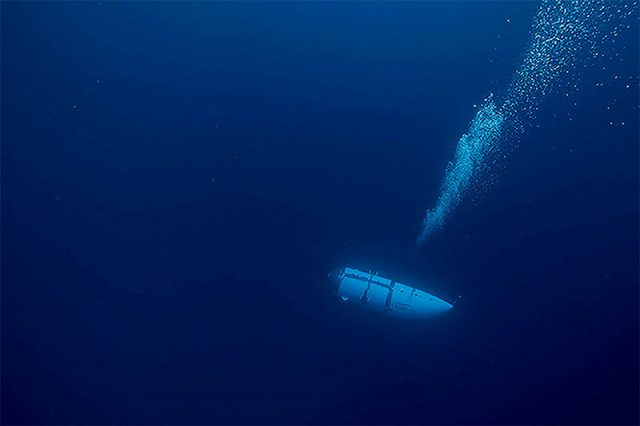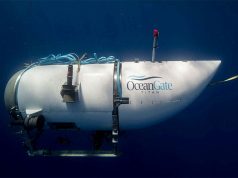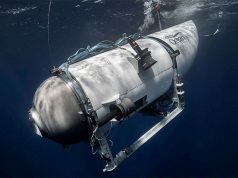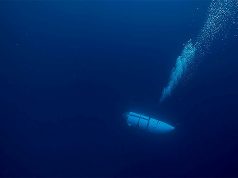
- Clock ticks down on vessel’s presumed air supply
- Titanic wreckage lies 2-plus miles beneath surface
- Rescue teams from U.S., Canada, France join in search
Search teams detected underwater sounds while scanning the North Atlantic for a tourist submersible that vanished with five people aboard during a deep-sea voyage to the century-old wreck of the Titanic, the U.S. Coast Guard said early on Wednesday.
RELATED: Titanic tourist submersible missing for third day with five aboard
The detection of the sounds by Canadian aircraft was reported by the Coast Guard as the clock ticked down to the last 24 hours of the craft’s presumed oxygen supply.
Robotic undersea search operations were diverted to the area but there was still no tangible sign of the missing vessel, the Coast Guard said on Twitter.
The 21-foot-long pilot-driven submersible Titan, operated by U.S.-based OceanGate Expeditions, lost contact with its parent surface vessel on Sunday morning about one hour, 45 minutes into what should have been a two-hour dive to the site of the world’s most famous shipwreck.
The mini-sub was designed to remain underwater for 96 hours, according to its specifications, giving its occupants until Thursday morning before their air tanks would run out, assuming that the Titan was still intact.
The fate of the submersible and those aboard remained a mystery as search teams from the U.S., Canada and France mounted an intensifying search in an area of open sea larger than the state of Connecticut.
The wreck of the Titanic, a British ocean liner that struck an iceberg during its maiden voyage on the night of April 14, 1912, and sank the next morning, lies some 12,500 feet (3,810 meters) beneath the surface – about 900 miles (1,450 km) east of Cape Cod, Massachusetts, and 400 miles (644 km) south of St. John’s, Newfoundland.
As of Tuesday, aircraft and ships from the U.S. Coast Guard, U.S. Navy and Canadian armed forces had combed more than 7,600 square miles of the North Atlantic, U.S. Coast Guard Captain Jamie Frederick told reporters at a press conference on day three of the search.
Those aboard Titan for a tourist expedition that costs $250,000 per person included British billionaire Hamish Harding, 58, and Pakistani-born businessman Shahzada Dawood, 48, with his 19-year-old son Suleman, who are both British citizens.
French explorer Paul-Henri Nargeolet, 77, and Stockton Rush, founder and CEO of OceanGate Expeditions, were also reported to be on board. Authorities have not confirmed the identity of any passenger.
RELATED: Factbox: Who’s on board the missing Titanic sub?
Robotic search redirected
The search effort included Lockheed P-3 Orion turboprop airplanes designed with sub-surface surveillance gear to detect submarines, Frederick said.
The Canadian military also dropped sonar buoys to listen for any sounds that might come from the Titan, and a commercial pipeline-laying vessel with a remote-controlled deepwater submersible was also searching near the site, he said.
Separately, a French research ship carrying its own deep-sea diving robot submersible was dispatched to the search area at the request of the U.S. Navy and was expected to arrive Wednesday night local time, the Ifremer research institute said.
Canada’s P-3 aircraft ended up detecting underwater noises in the search area on Tuesday, after which “ROV (remotely operated vehicle) operations were relocated in an attempt to explore the origin of the noises,” according to the Coast Guard tweets.
“The ROV searches have yielded negative results but continue,” the Coast Guard said, adding, that the P-3 data was shared with U.S. Navy experts for “further analysis which will be considered in future search plans.”
The Coast Guard did not detail the nature or extent of the sounds.
But CNN and Rolling Stone magazine, citing internal U.S. government communications, independently reported late on Tuesday that banging sounds were detected by Canadian aircraft at 30-minute intervals in the search area.
Rolling Stone, the first to report the news, said the sounds were picked up by sonar buoys and that additional sonar picked up more banging four hours later.
CNN cited a U.S. government memo as saying that additional sounds were heard about four hours after initial banging was detected, although the news channel said the second occurrence was not described as banging.
Bolted from outside
Rescuers face major obstacles both in finding the Titan and in saving the people aboard, according to experts.
In the event of a mid-dive emergency, the Titan’s pilot would likely have released weights to float back to the surface, according to Alistair Greig, a marine engineering professor at University College London. But absent communication, locating a van-sized submersible in the vast Atlantic would prove challenging, he said.
The submersible is sealed with bolts from the outside, preventing occupants from escaping without assistance even if it surfaces.
If the Titan were stuck on the ocean floor, a rescue effort would face even greater challenges due to extreme hydrostatic pressure and total darkness on the sea floor more than 2 miles deep. Titanic expert Tim Matlin said it would be “almost impossible to effect a sub-to-sub rescue” on the seabed.
The sinking of the Titanic, which killed more than 1,500 people, has been immortalized in books and films, including the 1997 blockbuster movie “Titanic,” which renewed popular interest in the wreck.
—Reporting by Steve Gorman and Joseph Ax; Additional reporting by Brendan O’Brien, Natalie Thomas, Aiden Nulty, Kanishka Singh, Ismail Shakil, Steve Scherer, Steve Holland, Daniel Trotta, Brad Brooks and Ariba Shahid; Editing by Raju Gopalakrishnan









